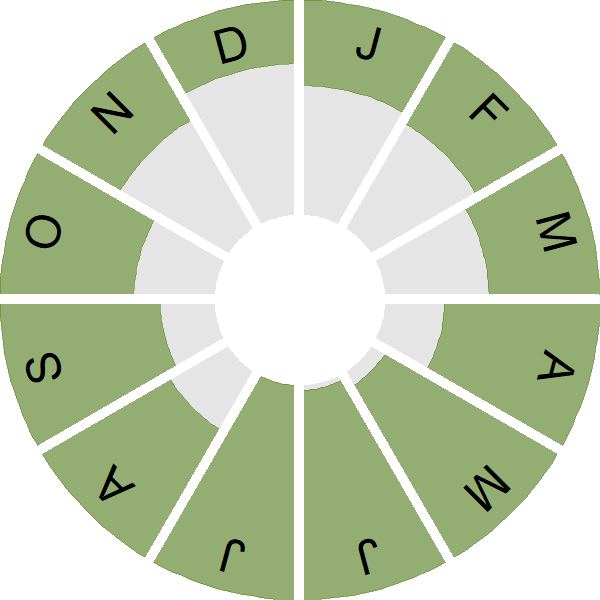Guillemot
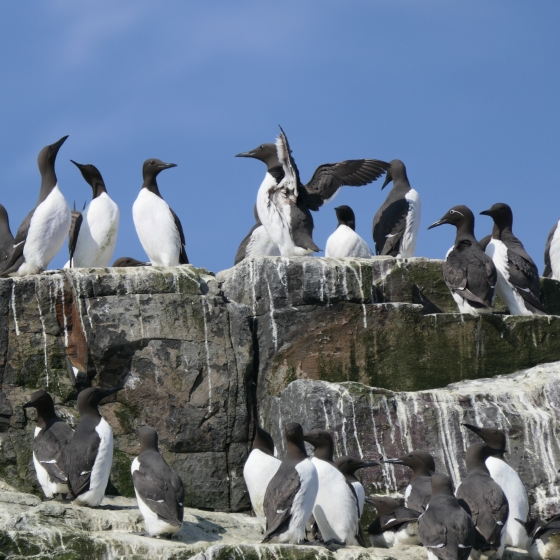
Introduction
Guillemots breed on rocky cliffs, using narrow ledges, and their colonies can be found around much of our coastline, including on isolated seastacks and suitable island outcrops.
Colonial breeding is the norm in this species and some colonies may number tens of thousands of individuals. Nest site locations vary between sites, with mainland sites restricted to narrow ledges safe from predators; on predator-free islands pairs may nest among rocks or even on bare ground.
During the winter months Guillemots may be encountered widely in coastal waters, though these birds are most abundant in those of the northern North Sea and off our western shores.

Key Stats
Identification
ID Videos
This section features BTO training videos headlining this species, or featuring it as a potential confusion species.
Winter Auks
Songs and Calls
Song:
Call:
Status and Trends
Conservation Status
Population Change
Guillemot is a regular breeder around the UK coast. The number of Guillemots recorded during the recent Seabirds Count census [Burnell et al. 2023] was 8% lower than the number counted during the Seabird 2000 census; the distribution had also changed, with population decreases in the north (particularly in the far north of Scotland) and increases in the south. This decline is in contrast to the previous trend which had shown a marked increase in Guillemot numbers since the Operation Seafarer census in the late 1960s.
Distribution
During winter, Guillemots are found around much of the coast of Britain & Ireland with the highest densities in west-coast waters and the North Sea coast of southeast Scotland and northeast England. Guillemot colonies are associated with steep cliffs and rocky offshore stacks and islands, and the lack of these habitats between Flamborough Head, Yorkshire and Durlston Head, Dorset is mirrored in the breeding distribution map.
Occupied 10-km squares in UK
or view it on Bird Atlas Mapstore.
or view it on Bird Atlas Mapstore.
European Distribution Map
Distribution Change
Change in occupied 10-km squares in the UK
or view it on Bird Atlas Mapstore.
or view it on Bird Atlas Mapstore.
Seasonality
Guillemots are recorded throughout the year though more consistently during summer at suitable coastal breeding sites.
Weekly pattern of occurrence
The graph shows when the species is present in the UK, with taller bars indicating a higher likelihood of encountering the species in appropriate regions and habitats.

Movement
Britain & Ireland movement
Foreign locations of birds ringed or recovered in Britain & Ireland
Dots show the foreign destinations of birds ringed in Britain & Ireland, and the origins of birds ringed overseas that were subsequently recaptured, resighted or found dead in Britain & Ireland. Dot colours indicate the time of year that the species was present at the location.
- Winter (Nov-Feb)
- Spring (Mar-Apr)
- Summer (May-Jul)
- Autumn (Aug-Oct)

European movements
EuroBirdPortal uses birdwatcher's records, such as those logged in BirdTrack to map the flows of birds as they arrive and depart Europe. See maps for this species here.
The Eurasian-African Migration Atlas shows movements of individual birds ringed or recovered in Europe. See maps for this species here.
Biology
Productivity and Nesting
Nesting timing
Egg measurements
Clutch Size
Survival and Longevity
Survival is shown as the proportion of birds surviving from one year to the next and is derived from bird ringing data. It can also be used to estimate how long birds typically live.
View number ringed each year in the Online Ringing Report.
lifespan
Survival of adults
Survival of juveniles
Biometrics
Wing length and body weights are from live birds (source).
Wing length
Body weight
Ring Size
Classification, names and codes
Classification and Codes
- Order: Charadriiformes
- Family: Alcidae
- Scientific name: Uria aalge
- Authority: Pontoppidan, 1763
- BTO 2-letter code: GU
- BTO 5-letter code: GUILL
- Euring code number: 6340
Alternate species names
- Catalan: somorgollaire comú
- Czech: alkoun úzkozobý
- Danish: Lomvie
- Dutch: Zeekoet
- Estonian: lõunatirk
- Finnish: etelänkiisla
- French: Guillemot marmette
- Gaelic: Eun-dubh-an-sgadain
- German: Trottellumme
- Hungarian: lumma
- Icelandic: Langvía
- Irish: Foracha
- Italian: Uria
- Latvian: tievknabja kaira
- Lithuanian: laibasnapis narunelis
- Norwegian: Lomvi
- Polish: nurzyk (zwyczajny)
- Portuguese: airo
- Slovak: norec tenkozobý
- Slovenian: lumna
- Spanish: Arao común
- Swedish: sillgrissla
- Welsh: Gwylog
- English folkname(s): Loom, Willock
Research
Causes of Change and Solutions
Causes of change
The recent decline in numbers may, in part, have been due to low productivity that occurred in some northern colonies between 2003 and 2007, which coincided with a decline in sandeel abundance [Burnell et al. 2023]. The commercial fishing industry can also negatively impact Guillemot populations through both bycatch, particularly in gillnets [Northridge et al. 2023], and overfishing of important prey species, which is likely to increase foraging pressure and decrease breeding productivity [Nettleship et al. 2018a]. Offshore wind farms are an additional pressure on Guillemots, through potential displacement of birds from foraging grounds [Peschko et al. 2020].
Increases in the sea surface temperature are causing changes in the abundance and distribution of Guillemot prey, such as sandeels [Erikstad et al. 2013; Heath et al. 2009; Régnier et al. 2017; Riordan & Birkhead 2018; Wanless et al. 2005], potentially resulting in a switch to less energy-rich alternative prey items [Heubeck 2009] which can result in a lower breeding success in areas where Guillemots are heavily dependent on sandeels in the breeding season. Guillemot adults, eggs and chicks are vulnerable to predation during the breeding season by a range of species, including Hooded Crows, Carrion Crows and Herring Gulls [Booth Jones 2020], a threat that increases in smaller auk colonies, which offer less protection for individual birds [Gilchrist 1999]. Guillemots are particularly susceptible to severe winter storms, which reduce foraging opportunities and can in extreme cases lead to starvation. Climate change is increasing the frequency of these extreme weather events (Field et al. 2012), which can lead to many dead birds being washed up in seabird wreck. In the winter of 2013/14, large wrecks occurred along British coasts, and post-mortems suggested starvation and some oil contamination as likely causes (Jessop 2014; Sellers 2014).
Publications (4)
The status of the UK’s breeding seabirds
Author: Stanbury, A.J., Burns, F., Aebischer, N.J., Baker, H., Balmer, D., Brown, A.F., Dunn, T., Lindley, P., Murphy, M., Noble, D.G., Owens, R. & Quinn, L.
Published: 2024
Five seabird species are added to the Birds of Conservation Concern Red List in this addendum to the 2021 update, bringing the total number of Red-listed seabird species to 10, up from six since seabirds were last assessed. The Amber List of seabirds moves from 19 to 14 species, and the Green List increases from one to two species.
29.09.24
Papers
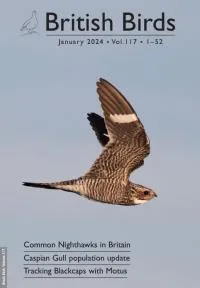
Current understanding of how climate change affects seabirds varies between regions and species in the North-East Atlantic
Author: Johnston, D.T., Humphreys, E.M., Davies, J.G., Evans, T., Howells, R.J. & Pearce-Higgins, J.W.
Published: 2025
BTO-led research identifies key gaps in our knowledge and understanding of how climate change is affecting seabirds.
27.02.25
Papers
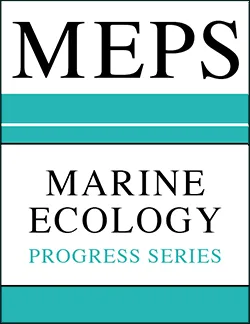
Seabird Population Trends and Causes of Change: 1986–2023
Author: Harris, S.J., Baker, H., Balmer, D.E., Bolton, M., Burton, N.H.K., Caulfield, E., Clarke, J.A.E., Dunn, T.E., Evans, T.J., Hereward, H.R.F., Humphreys, E.M., Money, S. and O’Hanlon, N.J.
Published: 2024
This report presents the latest seabird population trends in breeding abundance and productivity using data from the Seabird Monitoring Programme (SMP).The report documents changes in the abundance and productivity of breeding seabird species in Britain and Ireland from 1986 to 2023, and provides a detailed account of the 2021, 2022 and 2023 breeding seasons.This report includes both inland and coastal populations and trends from the Channel Islands, England, Isle of Man, Northern Ireland, Scotland, Wales and the Republic of Ireland, which are presented where sufficient data are available. The results from this report are used more broadly to assess the health of the wider environment, to inform policy and for conservation action.
21.11.24
Reports Research reports
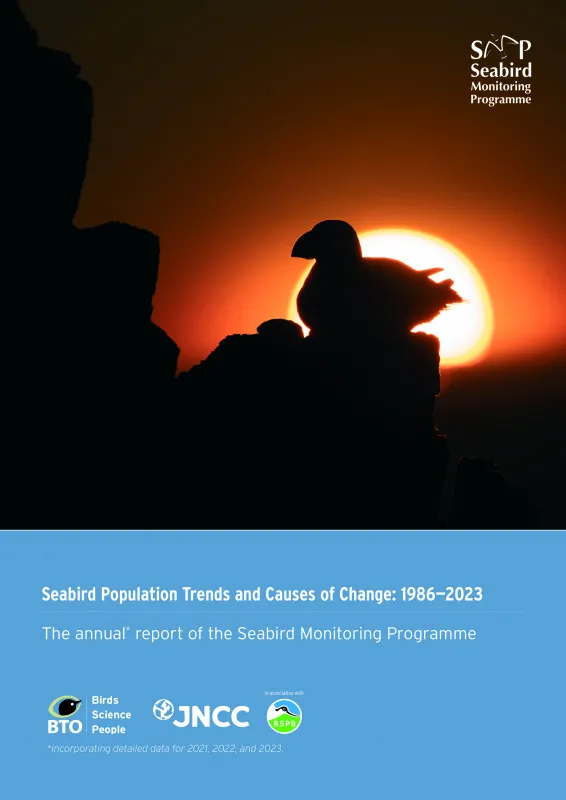
Northern Ireland Seabird Report 2023
Author: Booth, K.J. & El Haddad, H.
Published: 2024
The report includes detailed information about the population trends and breeding success of seabirds in Northern Ireland, over the 2023 breeding season. Notably, Fulmar and Kittiwake populations are reported to be experiencing continued declines, while Guillemot, Common Gull and Herring Gull populations show increases at most breeding sites.
15.04.24
Reports Northern Ireland Seabird Report


